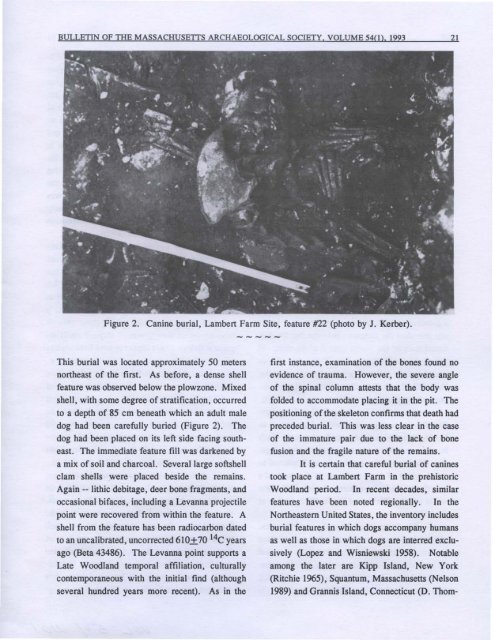Bulletin of the Massachusetts Archaeological Society, Vol. 54, No. 1 ...
Bulletin of the Massachusetts Archaeological Society, Vol. 54, No. 1 ...
Bulletin of the Massachusetts Archaeological Society, Vol. 54, No. 1 ...
Create successful ePaper yourself
Turn your PDF publications into a flip-book with our unique Google optimized e-Paper software.
BULLETIN OF THE MASSACHUSETTS ARCHAEOLOGICAL SOCIETY. VOLUME <strong>54</strong>(1). 1993 21<br />
Figure 2. Canine burial, Lambert Farm Site, feature #22 (photo by J. Kerber).<br />
This burial was located approximately 50 meters<br />
nor<strong>the</strong>ast <strong>of</strong> <strong>the</strong> first. As before, a dense shell<br />
feature was observed below <strong>the</strong> plowzone. Mixed<br />
shell, with some degree <strong>of</strong> stratification, occurred<br />
to a depth <strong>of</strong> 85 cm beneath which an adult male<br />
dog had been carefully buried (Figure 2). The<br />
dog had been placed on its left side facing sou<strong>the</strong>ast.<br />
The immediate feature fill was darkened by<br />
a mix <strong>of</strong>soil and charcoal. Several large s<strong>of</strong>tshell<br />
clam shells were placed beside <strong>the</strong> remains.<br />
Again -- lithic debitage, deer bone fragments, and<br />
occasional bifaces, including a Levanna projectile<br />
point were recovered from within <strong>the</strong> feature. A<br />
shell from <strong>the</strong> feature has been radiocarbon dated<br />
to an uncalibrated, uncorrected 610+70 14C years<br />
ago (Beta 43486). The Levanna point supports a<br />
Late Woodland temporal affiliation, culturally<br />
contemporaneous with <strong>the</strong> initial find (although<br />
several hundred years more recent). As in <strong>the</strong><br />
first instance, examination <strong>of</strong> <strong>the</strong> bones found no<br />
evidence <strong>of</strong> trauma. However, <strong>the</strong> severe angle<br />
<strong>of</strong> <strong>the</strong> spinal column attests that <strong>the</strong> body was<br />
folded to accommodate placing it in <strong>the</strong> pit. The<br />
positioning <strong>of</strong><strong>the</strong> skeleton confirms that death had<br />
preceded burial. This was less clear in <strong>the</strong> case<br />
<strong>of</strong> <strong>the</strong> immature pair due to <strong>the</strong> lack <strong>of</strong> bone<br />
fusion and <strong>the</strong> fragile nature <strong>of</strong> <strong>the</strong> remains.<br />
It is certain that careful burial <strong>of</strong> canines<br />
took place at Lambert Farm in <strong>the</strong> prehistoric<br />
Woodland period. In recent decades, similar<br />
features have been noted regionally. In <strong>the</strong><br />
<strong>No</strong>r<strong>the</strong>astern United States, <strong>the</strong> inventory includes<br />
burial features in which dogs accompany humans<br />
as well as those in which dogs are interred exclusively<br />
(Lopez and Wisniewski 1958). <strong>No</strong>table<br />
among <strong>the</strong> later are Kipp Island, New York<br />
(Ritchie 1965), Squantum, <strong>Massachusetts</strong> (Nelson<br />
1989) and Grannis Island, Connecticut (D. Thom-
















